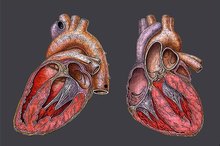The Best Exercises for a Deconditioned Heart
The term "deconditioned heart" can indicate different degrees of disability. If you have a deconditioned heart, you could have a disorder ranging from stable heart disease to severe heart damage. The type of exercise that you can do for a deconditioned heart will depend on your doctor's orders, the severity of the deconditioning and on exactly what has caused your problem. Your doctor may refer to an exercise program to get your heart back in shape as cardiac rehabilitation, or cardiac rehab. Don't start any exercise program without talking to your doctor first.
If you are experiencing serious medical symptoms, seek emergency treatment immediately.
Evaluation
If you have a severely deconditioned heart from serious heart disease, such as cardiomyopathy, which is damage to the heart muscle, your doctor may order no exercise at all to avoid further damage to the muscle. If you have deconditioning from stable or unstable heart disease, he may order a thorough evaluation to assess how much exercise your heart can handle before endorsing any type of exercise program. Cardiac catheterization, stress testing or ultrasound can all make up a cardiac evaluation before starting an exercise program. If you're recovering from a heart attack, your exercise program may all be done under the eyes of a physical therapist, who can assess your physical condition and watch for signs of further decompensation during exercise.
- If you have a severely deconditioned heart from serious heart disease, such as cardiomyopathy, which is damage to the heart muscle, your doctor may order no exercise at all to avoid further damage to the muscle.
- If you have deconditioning from stable or unstable heart disease, he may order a thorough evaluation to assess how much exercise your heart can handle before endorsing any type of exercise program.
Aerobic Exercise
6 Types of Heart Doctors You Should Know About
Learn More
Aerobic exercise strengthens your heart by causing it to beat faster and harder. The degree to which you can exercise will depend on your condition. Walking a short distance may be all that your heart can handle at first 1. Gradually, you will build up to walking further distances. Swimming and bicycling on a stationary bike can provide easy or difficult aerobic exercise. Over time, you may progress to dancing, running or more strenuous cardiac workouts. If you go to a gym, work with a trainer on different machines that allow you to increase the intensity over time. Keep your heart rate within the target range that your doctor or trainer suggests while you exercise. Wearing a monitor that tracks your heartbeat makes it easier to keep your heart rate within a safe range.
- Aerobic exercise strengthens your heart by causing it to beat faster and harder.
- Over time, you may progress to dancing, running or more strenuous cardiac workouts.
Weight-Bearing Benefits
In addition to aerobic exercise to strengthen your heart, your doctor may suggest weight-bearing exercises, which build muscle and bone and improve your physical condition. Weight-bearing exercise doesn't mean lifting 100-pound weights over your head; if you have a deconditioned heart, you will most likely start with light weights of just a few pounds each and increase gradually as your heart becomes stronger. Weight-bearing or strength exercises can include yoga, pilates or floor exercises such as sit-ups or push-ups as well as lifting weights. Aerobic exercises, such as walking, also qualify as weight-bearing exercises, even if it's just your own weight that you're moving.
- In addition to aerobic exercise to strengthen your heart, your doctor may suggest weight-bearing exercises, which build muscle and bone and improve your physical condition.
- Weight-bearing exercise doesn't mean lifting 100-pound weights over your head; if you have a deconditioned heart, you will most likely start with light weights of just a few pounds each and increase gradually as your heart becomes stronger.
Considerations
Side Effects of Exercise With a Cardiac Pacemaker
Learn More
Aim to exercise for 20 to 30 minutes at least three times per week. Wait 30 to 60 minutes after eating before exercising and don't exercise outdoors during the hottest part of the day or when it's extremely cold or windy. To prevent injury to your muscles, always include a five to 10-minute warm-up period of slow walking or other light exercise and a five to seven minute cool-down period of stretching. Walking provides the simplest and safest form of aerobic weight-bearing exercise, according to the Rogue Valley Medical Center. Stop exercising and notify your doctor if your heart rate remains elevated for more than five or six minutes after you stop exercising or if you experience any type of chest pain, nausea, shortness of breath or other signs of cardiac distress, warns the Yale University School of Medicine Heart Book.
- Aim to exercise for 20 to 30 minutes at least three times per week.
- Stop exercising and notify your doctor if your heart rate remains elevated for more than five or six minutes after you stop exercising or if you experience any type of chest pain, nausea, shortness of breath or other signs of cardiac distress, warns the Yale University School of Medicine Heart Book.
Related Articles
References
- An AARP Guide: Living with Heart Disease; Larry Katzenstein; February 2007
- Balady GJ, Ades PA, Bittner VA, et al. Referral, enrollment, and delivery of cardiac rehabilitation/secondary prevention programs at clinical centers and beyond: a presidential advisory from the American Heart Association. Circulation 2011; 124:2951.
- Smith SC Jr, Benjamin EJ, Bonow RO, et al. AHA/ACCF Secondary Prevention and Risk Reduction Therapy for Patients with Coronary and other Atherosclerotic Vascular Disease: 2011 update: a guideline from the American Heart Association and American College of Cardiology Foundation. Circulation 2011; 124:2458.
Writer Bio
A registered nurse with more than 25 years of experience in oncology, labor/delivery, neonatal intensive care, infertility and ophthalmology, Sharon Perkins has also coauthored and edited numerous health books for the Wiley "Dummies" series. Perkins also has extensive experience working in home health with medically fragile pediatric patients.









